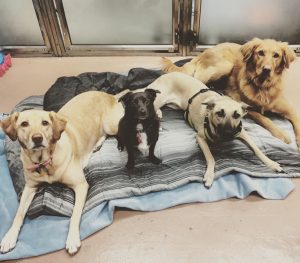
When you work in Veterinary Medicine there inevitably comes a time when it is your own furry member of the family that becomes the critically ill patient. That was me, with my sweet Bernese Mountain Dog, Chumani.
Every morning Chumani wakes up happy about life. She bounces around, happy that her people are finally moving around, the day is started, and she is going to get breakfast soon. But this one morning I woke up sick with the stomach bug, and it seemed Chumani did as well. She had vomited up some foamy bile. I got up, checked her out and she seemed ok. She was still bouncing around and happy go lucky, so I thought she was fine. I made my way to the sofa, as my husband got everyone on with their day. Our daughter was getting ready for school, the dogs were let out and then fed afterwards. My husband, Chad was loading up the car to take Adeline to town.
Once my husband left, I snuggled in and was about to take a nap when Chumani came running into the living room in a panic. She is an anxious dog, so I at first thought something had spooked her. However, she started to retch like she was going to vomit but nothing came out. I ran over to her and put my hands on her stomach and felt a very large bloated stomach. I knew immediately, I was dealing with Gastric Dilation- Volvulus (GDV) or as its more commonly known as bloat.
GDV is a condition where the stomach dilates because of food and gas. If the stomach dilates too much, then it can cause the stomach to turn on itself, cutting off blood supply to vital abdominal organs. I knew that quick action was crucial, so I called the veterinary clinic and let them know that I was rushing Chumani down to be seen. Radiographs were done as soon as we arrived, and it was confirmed that she had GDV.
GDV or “Bloat” is a life-threatening condition. When the stomach bloats and then twists, there isn’t much time to get the patient to the hospital and into emergency surgery before they become critical. Any dog could develop GDV, but its more common in larger dogs with deep chests like Great Danes, Weimaraners, German Shepherds, and Bernese Mountain Dogs, which is what Chumani is. She presented with the classic symptoms which include an anxious look, drooling, bloated abdomen and retching without producing vomit.
There have been several studies that have looked at risk factors and causes for GDV in dogs, but this syndrome is still not fully understood. However, it is known that there is an association in dogs that have deep chests, are fed large meals, are anxious, older or are related to other dogs that have had the condition.
There is no way to 100% prevent GDV from happening, but there are a few things that you can do to lower the probability. Feed smaller meals, two to three times daily. In addition, do not elevate food bowls. This was a popular idea at one time to help prevent “bloat”, but recent studies have shown that it may attribute to it. Softening dry food with warm water or adding some canned food and avoiding stressful situations are also know to help lower the chances of bloat. However, even with all these suggestions, it can still happen.
I was one of the lucky ones. I was blessed to be home sick, I knew what to look for, and I sought veterinary care immediately. Chumani did great through surgery, and is living a healthy, happy life with us.
Submitted by Chrissy Curth
